Fast Facts & Figures About Social Security, 2002
Did You Know That...
- SSA paid benefits to more than 50 million people in 2001.
- Social Security benefits were awarded to over 4 million people.
- Social Security provided at least half the income for 64% of aged persons.
- Women accounted for 57% of adult Social Security beneficiaries.
- The average age of Disability Insurance beneficiaries has fallen from just over 57 in 1960 to 50.9.
- Disability was the reason for paying 80% of SSI beneficiaries.
Abbreviations
- AIME
- Average Indexed Monthly Earnings
- DI
- Disability Insurance
- HI
- Hospital Insurance
- OASDI
- Old-Age, Survivors, and Disability Insurance
- OASI
- Old-Age and Survivors Insurance
- PIA
- Primary Insurance Amount
- SSA
- Social Security Administration
- SSI
- Supplemental Security Income
General Information, 2002
Cost-of-living adjustment
Tax rates
| Program | Employer and employee, each |
Self-employed |
|---|---|---|
| Total | 7.65 | 15.30 |
| OASI | 5.30 | 10.60 |
| DI | 0.90 | 1.80 |
| HI | 1.45 | 2.90 |
Average wage index
| Year | Index |
|---|---|
| 2000 | 32,155 |
| 2001 (estimated) | 33,897 |
| 2002 (estimated) | 34,943 |
Maximum earnings subject to Social Security taxes
| Program | Amount |
|---|---|
| OASDI | 84,900 |
| HI | No limit |
Taxes payable
| Type of earner | OASI | DI | HI |
|---|---|---|---|
| Average earner | 1,852 | 314 | 507 |
| Maximum earner | 4,500 | 764 | No limit |
| Self-employed maximum earner | 8,999 | 1,528 | No limit |
Quarters of coverage
- $870 in earnings equals 1 quarter of coverage (that is, 1 credit)
- $3,480 is the maximum earnings needed for 4 quarters of coverage (4 credits) in a given year
Retirement earnings test
| Period | Annually | Monthly |
|---|---|---|
| Ages 62–64 ($1 for $2 withholding rate) | 11,280 | 940 |
| Calendar year attaining retirement age ($1 for $3 withholding rate) a | 30,000 | 2,500 |
| After calendar year attaining retirement age or older | No limit | No limit |
| a. Test no longer applies beginning in the month in which retirement age is reached. | ||
Age for full retirement benefit
| Applicable to workers who were born in year— |
Full benefit at age— |
|---|---|
| 1940 | 65 and 6 months |
| 1941 | 65 and 8 months |
| 1942 | 65 and 10 months |
| 1943–54 | 66 |
| 1955 | 66 and 2 months |
| 1956 | 66 and 4 months |
| 1957 | 66 and 6 months |
| 1958 | 66 and 8 months |
| 1959 | 66 and 10 months |
| 1960 and later | 67 |
Benefit formula bend points
Primary insurance amount equals:
90% of the first $592 of AIME, plus
32% of AIME over $592 through $3,567, plus
15% of AIME over $3,567
Maximum family benefit equals:
150% of the first $756 of PIA, plus
272% of PIA over $756 through $1,092, plus
134% of PIA over $1,092 through $1,424, plus
175% of PIA over $1,424
Disability thresholds
Substantial gainful activity:
$780 per month for nonblind persons
$1,300 per month for blind persons
Trial work period:
$560 per month
OASDI administrative expenses
Trust fund operations
| Calendar year | Income | Outgo | Fund at end of year |
|---|---|---|---|
| 2001 (actual) | |||
| OASI | 518.1 | 377.5 | 1,071.5 |
| DI | 83.9 | 61.4 | 141.0 |
| 2002 (estimated) | |||
| OASI | 537.4 | 393.7 | 1,215.3 |
| DI | 87.0 | 71.4 | 156.5 |
| SOURCE: 2002 Trustees' Report. | |||
Benefit payments
| Calendar year | Total | OASI | DI |
|---|---|---|---|
| 2000 | 4.13 | 3.57 | 0.56 |
| 2001 | 4.23 | 3.65 | 0.58 |
Workload
| Type of filing | Number |
|---|---|
| OASI claims | 3.1 |
| DI claims | 1.7 |
| SSI applications | 1.7 |
Supplemental Security Income
Federal payment standard:
$545 individual, $817 couple
Resource limits:
$2,000 individual, $3,000 couple
Student exclusion limits:
$5,430
Poverty thresholds
| Family unit | 1999 | 2000 | 2001 (preliminary) |
|---|---|---|---|
| Aged individual | 7,990 | 8,259 | 8,494 |
| Family of two, aged head | 10,075 | 10,419 | 10,705 |
| Family of four | 17,029 | 17,603 | 18,267 |
| SOURCE: U.S. Census Bureau. | |||
Income of the Aged Population
Size of Income, 1962 and 2000
Median annual income for both married couples and nonmarried persons (aged 65 or older) has increased markedly since 1962 (the earliest year for which data are available). Even after adjusting for inflation, median income has risen 91% for married couples and 98% for nonmarried persons.
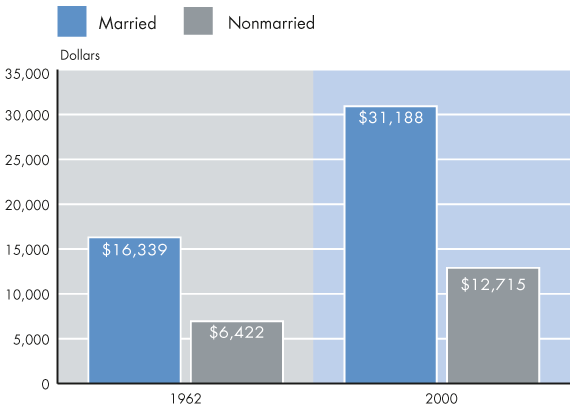
Receipt of Income, 1962 and 2000
Social Security benefits—the most common source of income in 1962—are now almost universal. The proportion of the aged population with asset income—the next most common source—has seen a modest increase. Over the 38-year period, receipt of private pensions has tripled, and receipt of government pensions has increased by over 50%. A smaller proportion of couples and nonmarried persons aged 65 or older received earnings in 2000 than in 1962.
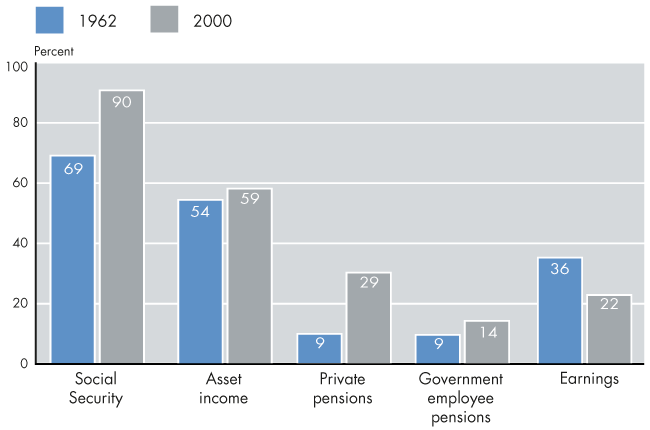
| Source of income | 1962 | 2000 |
|---|---|---|
| Social Security | 69 | 90 |
| Asset income | 54 | 59 |
| Private pensions | 9 | 29 |
| Government employee pensions | 9 | 14 |
| Earnings | 36 | 22 |
Shares of Aggregate Income, 1962 and 2000
In 1962, Social Security, private and government employee pensions, income from assets, and earnings made up only 84% of the total income of the aged, compared with 96% in 2000. Although private pensions still accounted for only a small proportion of total income in 2000, they tripled their share over this period—from 3% to 9%. The share from earnings declined from 28% to 23%.
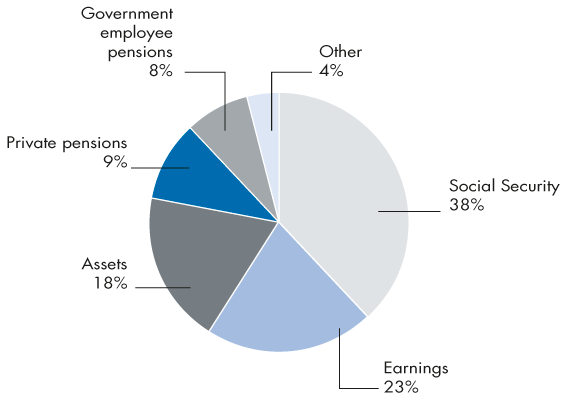
Reliance on Social Security, 2000
The OASDI program paid benefits to 90% of persons aged 65 or older. It was the major source of income (providing at least 50% of total income) for 64% of aged beneficiaries (couples or nonmarried persons), and it was the only source of income for 20%.
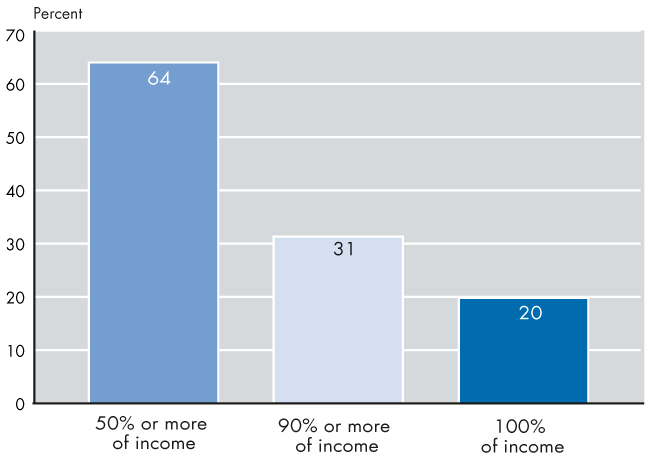
Poverty Status Based on Family Income, 2000
The aged poor are those with income below the poverty line. The near poor have income below 125% of the poverty line. Nonmarried persons and minorities have the highest poverty rates, ranging from 15% to 22%. Married persons have the lowest poverty rates, with 5% poor and 3% near poor. Overall, 10% are poor and 7% near poor.
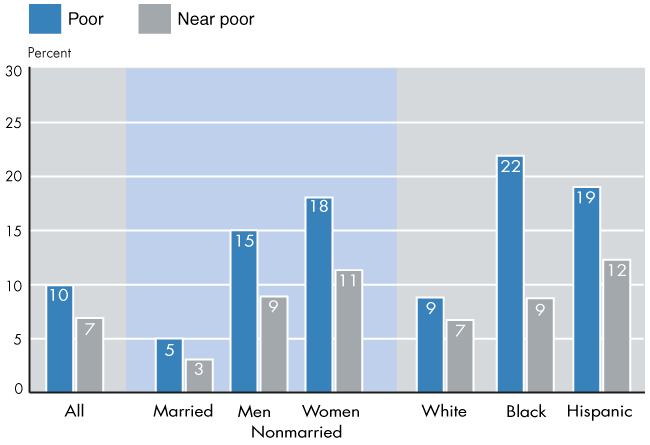
| Characteristic | Percent poor |
Percent near poor |
|---|---|---|
| All persons | 10 | 7 |
| By marital status | ||
| Married | 5 | 3 |
| Nonmarried men | 15 | 9 |
| Nonmarried women | 18 | 11 |
| By race and Hispanic origin | ||
| White | 9 | 7 |
| Black | 22 | 9 |
| Hispanic | 19 | 12 |
OASDI Program
Covered Earnings, 1937–2001
People contribute to Social Security through payroll taxes or self-employment taxes (FICA and SECA), as required by the Federal Insurance Contributions Act. The maximum taxable amount is updated annually based on increases in the average wage. Of the 153 million workers with Social Security taxable earnings in 2001, 6% had earnings that equaled or exceeded the maximum amount subject to taxes, compared with 3% when the program began and a peak of 35% in 1965. About 83% of earnings in covered employment were taxable in 2001, compared with 92% in 1937.
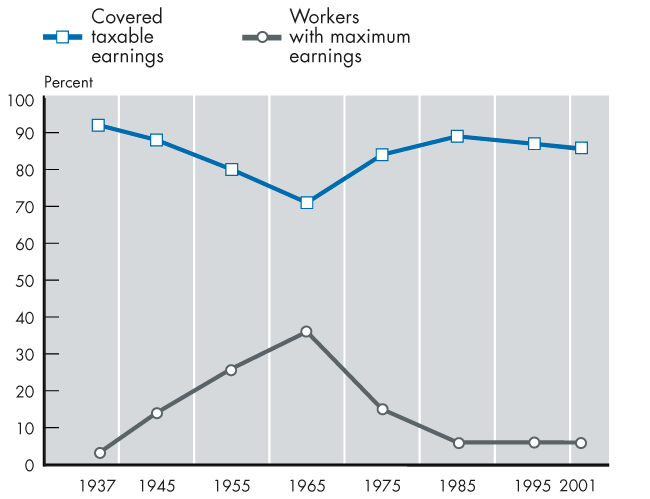
Insured Status, 1970–2002
The percentage of persons aged 20 or older who are insured for benefits has steadily increased over time. The percentage permanently insured (with enough covered work experience to qualify for retired-worker benefits at retirement age) rose from 50% in 1970 to 69% in 2002. The percentage fully insured increased from 77% to 89%. To be fully insured, a worker must have at least one quarter of coverage for each year elapsed after age 21 (but no earlier than 1950) and before the year in which he or she attains age 62 or becomes disabled. To be currently insured for disability at ages 20 to 65, the worker must be fully insured and have at least 20 quarters of coverage during the last 40 quarters. (Requirements for currently insured status are somewhat different for persons younger than age 31.)
| Year | Population aged 20 or older | Population aged 20–65 | |||
|---|---|---|---|---|---|
| Millions | Percentage permanently insured |
Percentage fully insured |
Millions | Percentage insured for disability |
|
| 1970 | 135.2 | 50 | 77 | 113.2 | 62 |
| 1975 | 147.5 | 50 | 80 | 122.9 | 65 |
| 1980 | 162.0 | 53 | 83 | 133.3 | 70 |
| 1985 | 175.1 | 57 | 84 | 144.1 | 73 |
| 1990 | 186.0 | 63 | 86 | 151.9 | 76 |
| 1995 | 194.7 | 66 | 87 | 160.5 | 78 |
| 2000 | 204.7 | 69 | 88 | 169.2 | 79 |
| 2002 | 209.1 | 69 | 89 | 173.2 | 80 |
| SOURCE: Office of the Chief Actuary, SSA. | |||||
| NOTE: The population in the Social Security area includes residents of the 50 states and the District of Columbia; residents of outlying areas; federal civilian employees and Armed Forces abroad and their dependents; crew members of merchant vessels; and certain other U.S. citizens residing abroad. | |||||
Insured Status, by Sex, 1970 and 2002
Although men are more likely than women to be insured, the gender gap is shrinking. The proportion of men who are insured has remained essentially stable, with 93% fully insured and 85% insured for disability. By contrast, the proportion of women who are insured has increased dramatically—from 63% to 84% fully insured and from 41% to 75% insured for disability.

| Sex | 1970 | 2002 |
|---|---|---|
| Fully insured | ||
| Men | 92 | 93 |
| Women | 63 | 84 |
| Insured for disability | ||
| Men | 85 | 85 |
| Women | 41 | 75 |
New Benefit Awards, 2001
Benefits were awarded to 4.2 million persons: of those, 43% were retired workers and 17% were disabled workers. The remaining 40% were spouses, children, survivors, or dependents of workers who received benefits based on the worker's earnings record. These awards represent not only new entrants to the benefit rolls but also persons already on the rolls who become entitled to a different benefit, particularly conversions of disabled-worker benefits to retired-worker benefits at age 65.
| Beneficiary | Number (thousands) |
Percent |
|---|---|---|
| Total | 4,162 | 100 |
| Retired workers and dependents | 2,204 | 53 |
| Workers | 1,779 | 43 |
| Spouses and children | 425 | 10 |
| Disabled workers and dependents | 1,118 | 27 |
| Workers | 691 | 17 |
| Spouses and children | 427 | 10 |
| Survivors of deceased workers | 840 | 20 |

New Awards to Workers, 1960–2001
Awards to retired workers have increased considerably since 1960 but proportionately much less than awards to disabled workers. The patterns of growth have also differed. The number of awards to retired workers climbed steadily—from 1 million in 1960 to 1.7 million in 1985. Over the next 10 years, it tapered off slightly, rose to almost 2 million in 2000, then declined to 1.8 million in 2001. Disabled-worker awards increased gradually—from 208,000 in 1960 to 592,000 in the mid-seventies—before falling to 377,000 in 1985. The number then rose, reaching 691,000 in 2001.
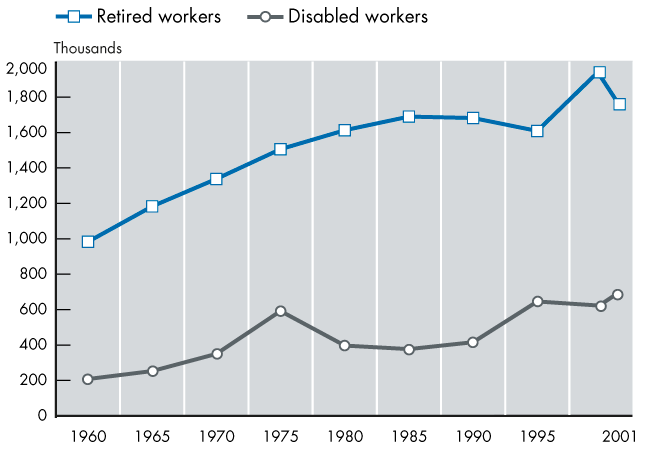
| Year | Retired workers |
Disabled workers |
|---|---|---|
| 1968 | 1200.00 | 323.00 |
| 1969 | 1272.78 | 344.74 |
| 1970 | 1338.11 | 350.38 |
| 1971 | 1391.40 | 415.90 |
| 1972 | 1461.40 | 455.44 |
| 1973 | 1493.19 | 491.62 |
| 1974 | 1413.15 | 535.98 |
| 1975 | 1505.75 | 592.05 |
| 1976 | 1475.77 | 551.46 |
| 1977 | 1593.63 | 568.87 |
| 1978 | 1472.79 | 464.42 |
| 1979 | 1590.85 | 416.71 |
| 1980 | 1612.67 | 396.56 |
| 1981 | 1578.99 | 351.85 |
| 1982 | 1618.41 | 297.13 |
| 1983 | 1669.74 | 311.55 |
| 1984 | 1607.37 | 362.00 |
| 1985 | 1690.49 | 377.37 |
| 1986 | 1734.25 | 416.87 |
| 1987 | 1681.72 | 415.85 |
| 1988 | 1654.07 | 409.49 |
| 1989 | 1656.74 | 425.58 |
| 1990 | 1664.75 | 467.98 |
| 1991 | 1695.35 | 536.43 |
| 1992 | 1707.95 | 636.64 |
| 1993 | 1661.28 | 635.24 |
| 1994 | 1625.35 | 631.87 |
| 1995 | 1609.17 | 645.83 |
| 1996 | 1581.45 | 624.34 |
| 1997 | 1718.62 | 587.42 |
| 1998 | 1631.51 | 608.13 |
| 1999 | 1690.02 | 620.49 |
| 2000 | 1960.65 | 621.65 |
| 2001 | 1779.23 | 691.31 |
Benefits in Current-Payment Status, December 2001
Almost 46 million beneficiaries were in current-payment status, that is, they were being paid a benefit. The majority of those beneficiaries were retired workers.
| Beneficiary | Number (thousands) |
Percent |
|---|---|---|
| Total | 45,878 | 100 |
| Retired workers and dependents | 32,046 | 70 |
| Workers | 28,837 | 63 |
| Spouses and children | 3,209 | 7 |
| Disabled workers and dependents | 6,913 | 15 |
| Workers | 5,274 | 11 |
| Spouses and children | 1,639 | 4 |
| Survivors of deceased workers | 6,918 | 15 |
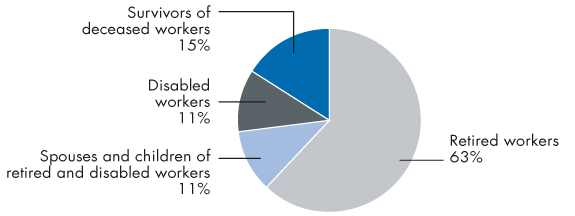
Average Benefit Amounts, 2001
Benefits payable to workers who retire at the full retirement age and to disabled workers are equal to 100% of the PIA (subject to any applicable deductions). At the full retirement age, widows' benefits are also payable at 100% of the insured worker's PIA. Nondisabled widows and widowers can receive reduced benefits at age 60. Disabled widows can receive benefits at age 50. Spouses, children, and parents receive a smaller proportion of the worker's PIA than widows do.
| Beneficiary | New awards | Current-payment status |
|---|---|---|
| Total | 716 | 796 |
| Retired workers | 878 | 874 |
| Spouses | 341 | 443 |
| Children | 394 | 413 |
| Disabled workers | 869 | 814 |
| Spouses | 228 | 207 |
| Children | 233 | 238 |
| Survivors | ||
| Nondisabled widows and widowers | 736 | 841 |
| Disabled widows and widowers | 547 | 537 |
| Widowed mothers and fathers | 635 | 621 |
| Surviving children | 593 | 571 |
| Parents | 771 | 729 |
Hypothetical Benefit Amounts, 2002
A covered worker who had worked continuously at low wages (45% of the national average wage) and who claimed benefits at age 62 in January 2002 would receive a monthly benefit of $565. One who had earnings at or above the maximum amount subject to Social Security taxes and who claimed benefits at age 65 would receive $1,660. Someone who claimed benefits at age 70, which maximizes the effect of the delayed retirement credit, would receive $1,988.
| Earnings | Age 62 | Age 65 | Age 70 |
|---|---|---|---|
| Low | 565 | 682 | 815 |
| Average | 931 | 1,127 | 1,358 |
| High | 1,217 | 1,467 | 1,748 |
| Maximum | 1,375 | 1,660 | 1,988 |
| SOURCE: Office of the Chief Actuary, SSA. | |||
| NOTE: Low earnings are defined as 45% of the national average index, average earnings are equal to the index, high earnings are 160% of the index, and maximum earnings are equal to the OASDI contribution and benefits base. | |||
Beneficiaries, by Age, December 2001
Of all OASI beneficiaries with benefits in current-payment status, 92% were aged 62 or older. Among DI beneficiaries (disabled workers and their spouses and children), 89% were under age 62.
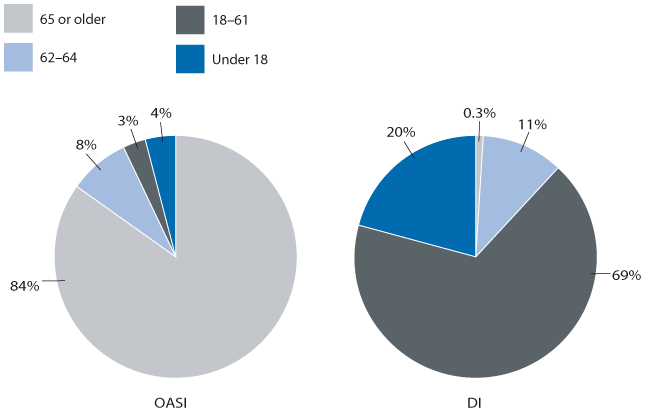
| Age | OASI | DI |
|---|---|---|
| Under 18 | 4 | 20 |
| 18–61 | 3 | 69 |
| 62–64 | 8 | 11 |
| 65 or older | 84 | 0.3 |
Disabled-Worker Beneficiaries, by Age, 1960–2001
The average age of disabled-worker beneficiaries in current-payment status has declined substantially since 1960, when DI benefits first became available to persons younger than age 50. In that year, the average age of a disabled worker was 57.2 years. The rapid drop in average age in the following years reflects a growing number of awards to workers under 50. By 1995, the average age had fallen to a low of 49.8, and by 2001, it had risen slightly, to 50.9.
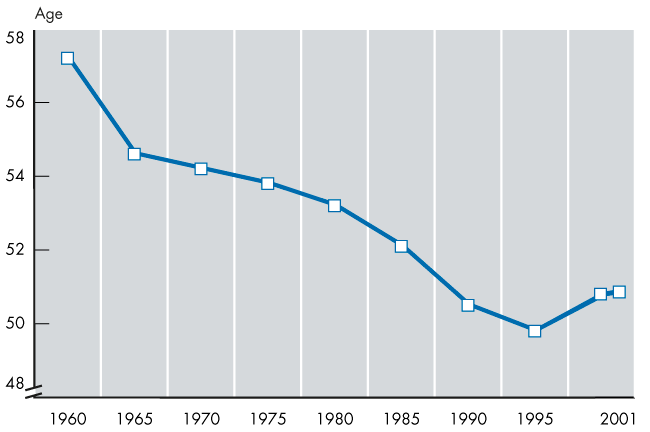
| Year | Disabled workers |
|---|---|
| 1960 | 57.2 |
| 1965 | 54.7 |
| 1970 | 54.2 |
| 1975 | 53.8 |
| 1980 | 53.2 |
| 1985 | 52.1 |
| 1990 | 50.5 |
| 1995 | 49.8 |
| 2000 | 50.8 |
| 2001 | 50.9 |
Beneficiaries, by Sex, December 2001
Of all adults receiving monthly Social Security benefits, 43% were men and 57% were women. Eighty-one percent of the men and 57% of the women received retired-worker benefits. About one-fifth of the women received survivors benefits.
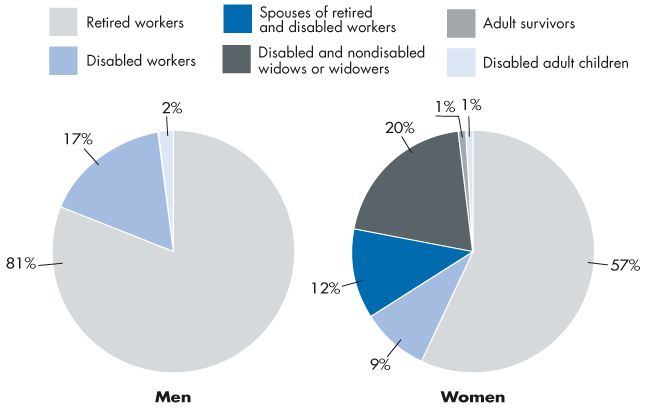
| Type of beneficiary | Men | Women |
|---|---|---|
| Retired workers | 81 | 57 |
| Disabled workers | 17 | 9 |
| Spouses of retired and disabled workers | a | 12 |
| Disabled and nondisabled widow(er)s | a | 20 |
| Adult survivors | a | 1 |
| Disabled adult children | 2 | 1 |
| a. Less than 0.5 percent. | ||
Average Monthly Benefit, by Sex, December 2001
Among retired and disabled workers who collected benefits based on their own work records, men received a higher average monthly benefit than women. For those with benefits based on another person's work record (spouses and survivors), women had higher average benefits.
| Beneficiary | Men | Women |
|---|---|---|
| Total | 961 | 722 |
| Retired workers | 985 | 756 |
| Spouses | 250 | 445 |
| Disabled workers | 914 | 688 |
| Spouses | 165 | 208 |
| Survivors | ||
| Nondisabled widows and widowers | 637 | 842 |
| Disabled widows and widowers | 375 | 541 |
| Mothers and fathers | 528 | 626 |
Women Beneficiaries, 1940–2001
The proportion of women among retired-worker beneficiaries has quadrupled since 1960. The percentage climbed steadily from 12% in 1940 to 47% in 1980, leveling off at 48% in 2001. The proportion of women among disabled-worker beneficiaries has more than doubled since 1957, when DI benefits first became payable. The percentage rose steadily from 20% in 1957 to 35% in 1990 and 44% in 2001.
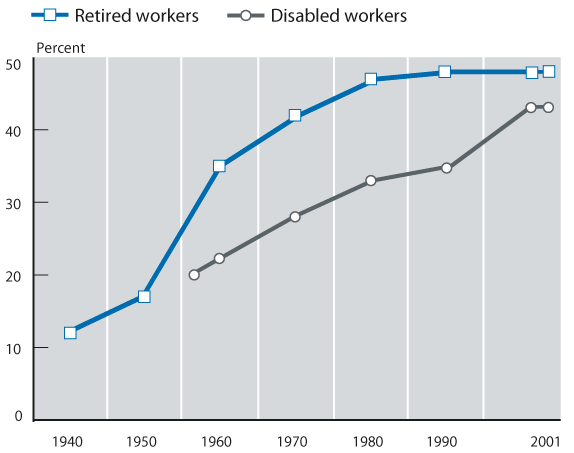
| Year | Retired workers |
Disabled workers |
|---|---|---|
| 1940 | 11.6 | -- |
| 1950 | 17.1 | -- |
| 1957 | -- | 19.1 |
| 1960 | 35.3 | 21.8 |
| 1970 | 42.4 | 28.4 |
| 1980 | 46.5 | 32.6 |
| 1990 | 47.7 | 34.7 |
| 2000 | 48.2 | 43.3 |
| 2001 | 48.2 | 43.9 |
| NOTE: -- = not available. | ||
Women with Dual Entitlement, 1960–2001
The proportion of women aged 62 or older who are receiving benefits as dependents (that is, on the basis of their husband's earnings record only) has been declining—from 57% in 1960 to 34% in 2001. At the same time, the proportion of women with dual entitlement (that is, paid on the basis of both their own earnings record and that of their husbands) has been increasing—from 5% in 1960 to 28% in 2001.
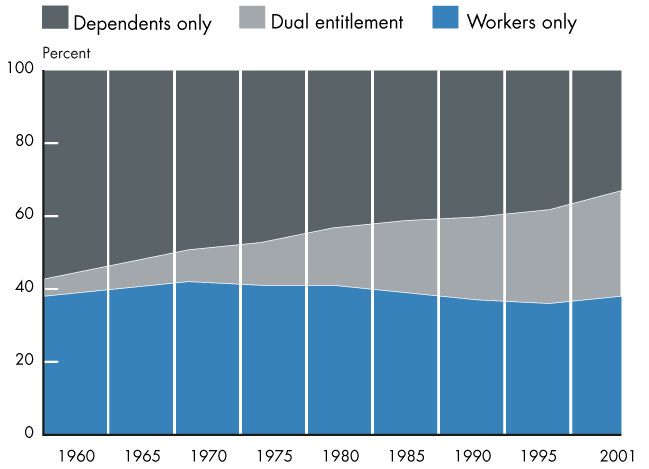
SSI Program
Beneficiaries, 1974–2001
Shortly after the SSI program began in 1974, the number of persons receiving federally administered payments rose to 4 million. It remained at about that level until the mid-1980s, then rose through the mid-1990s. In 2001, it stood at almost 6.7 million.
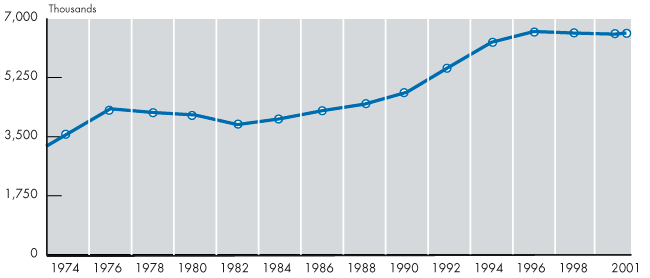
Payment Amounts, by Age, December 2001
The average federally administered SSI payment was $394. Payments varied by age group, ranging from an average of $476 for beneficiaries under 18 to $317 for those 65 or older.
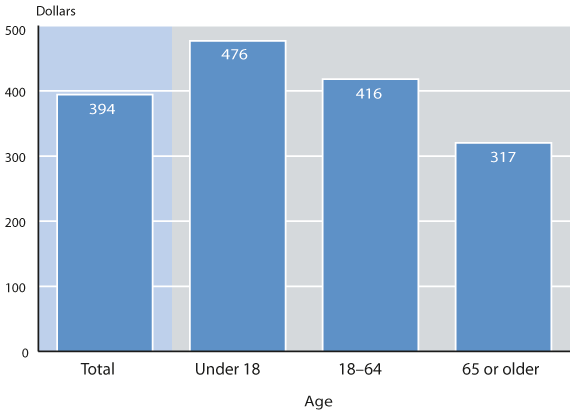
Federally Administered Payments, December 2001
Nearly 6.7 million persons received federally administered SSI payments. The majority received federal SSI only. States have the option of supplementing the federal benefit rate and are required to do so if that rate is less than the income the beneficiary would have had under the former state program.
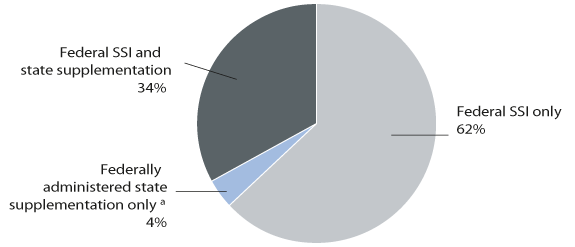
Basis for Eligibility and Age of Beneficiaries, December 2001
Nineteen percent of SSI beneficiaries had benefits awarded on the basis of age, the rest on the basis of disability. Almost one-third of the beneficiaries were aged 65 or older. In the SSI program—unlike the OASDI program—a disabled beneficiary is still classified as "disabled" after reaching age 65. DI beneficiaries are converted to the retirement program when they attain age 65.
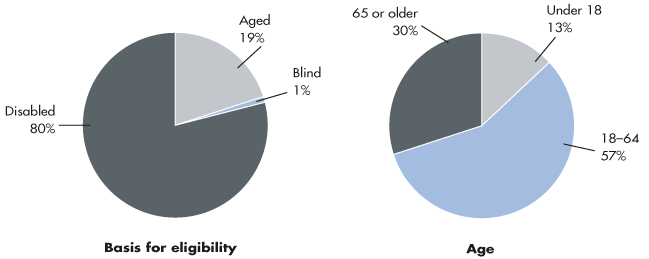
Beneficiaries Aged 65 or Older, 1974–2001
The proportion of SSI beneficiaries aged 65 or older has declined from 61% in January 1974 to 30% in December 2001. The overall long-term growth of the SSI program has occurred because of an increase in the number of disabled beneficiaries, most of whom are under age 65.
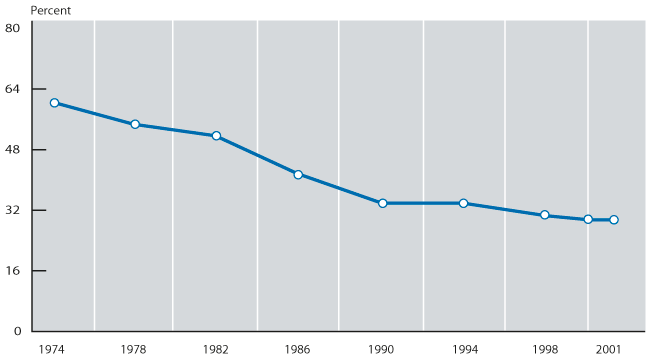
Beneficiaries, by Sex and Age, December 2001
Overall, 58% of the 6.7 million SSI beneficiaries were women, but that percentage varied greatly by age group. Women accounted for 71% of the 2 million beneficiaries aged 65 or older, 57% of the 3.8 million beneficiaries aged 18–64, and 36% of the 0.9 million beneficiaries under age 18.
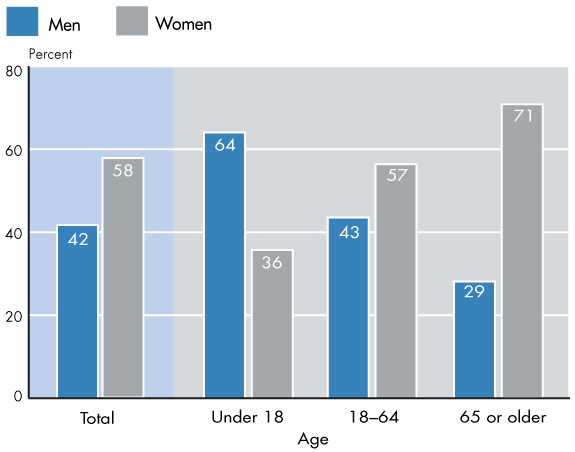
| Age | Men | Women |
|---|---|---|
| All ages | 42 | 58 |
| Under 18 | 64 | 36 |
| 18-64 | 43 | 57 |
| 65 or older | 29 | 71 |
Other Income, December 2001
Fifty-eight percent of SSI beneficiaries aged 65 or older received OASDI benefits, as did about 30% of those aged 18–64 and 7% of those under age 18. Other types of unearned income, such as veterans' pensions or income from assets, were reported most frequently among those under age 18 (18%) and those aged 65 or older (16%). Earned income was most prevalent (7%) among those 18–64.
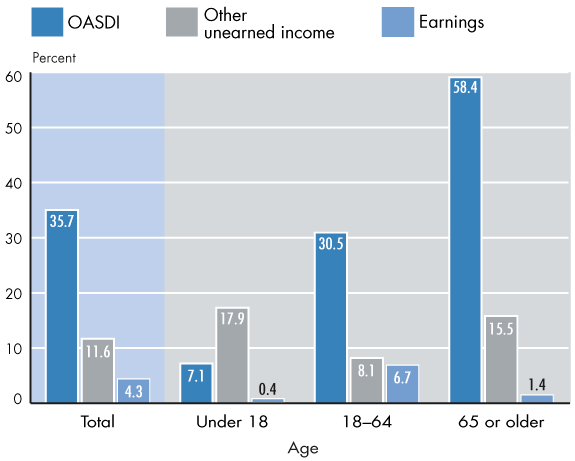
| Age | OASDI | Other unearned income |
Earnings |
|---|---|---|---|
| All ages | 35.7 | 11.6 | 4.3 |
| Under 18 | 7.1 | 17.9 | 0.4 |
| 18-64 | 30.5 | 8.1 | 6.7 |
| 65 or older | 58.4 | 15.5 | 1.4 |
OASDI and/or SSI
All Beneficiaries, December 2001
More than 50 million people received a payment from Social Security. Most (43.5 million) received OASDI benefits only, about 4.2 million received SSI only, and 2.4 million received payments from both programs.
| Beneficiaries receiving OASDI, SSI, or both |
Number (thousands) |
|---|---|
| All beneficiaries | 50,176 |
| Total receiving | |
| OASDI | 45,878 |
| OASDI only | 43,488 |
| SSI | 6,688 |
| SSI only | 4,298 |
| Both OASDI and SSI | 2,390 |
| NOTE: SSI includes federal SSI payments and federally administered state supplementation. | |

Aged Beneficiaries, December 2001
Aged or survivors benefits were paid to 33.8 million people aged 65 or older. About 1.2 million received both OASI and SSI.
| Beneficiary | Number (thousands) |
|---|---|
| Aged 65 or older, total (unduplicated) | 33,752 |
| OASI, total a | 32,923 |
| Retired workers | 26,267 |
| Spouses b | 2,418 |
| Nondisabled widow(er)s | 4,174 |
| Disabled adult children aged 65 or older | 65 |
| SSI, total c | 1,995 |
| Receiving SSI only | 829 |
| Concurrently receiving both OASI and SSI | 1,166 |
| NOTE: SSI includes federal SSI payments and federally administered state supplementation. | |
| a. Includes 3,200 persons who received dependent parents benefits, special age-72 benefits, or mothers/fathers benefits. | |
| b. Includes 23,000 spouses of disabled workers aged 65 or older. | |
| c. Includes 730,700 disabled or blind SSI beneficiaries aged 65 or older. | |
Disabled Beneficiaries, December 2001
Payments based on the beneficiary's own disability were made to 9.6 million people under age 65. Fifty-one percent received Disability Insurance payments under the OASDI program only, 36% received payments from the SSI program only, and 13% received payments from both programs.
| Payments | Number (thousands) |
|---|---|
| Total | 9,619 |
| Disability Insurance | 6,150 |
| Workers | 5,274 |
| Children aged 18–64 | 672 |
| widow(er)s | 204 |
| Disability Insurance only | 4,926 |
| SSI disability a | 4,693 |
| Aged 18–64 | 3,811 |
| Under age 18 | 882 |
| SSI disability only | 3,469 |
| Both Disability Insurance and SSI | 1,224 |
| NOTE: SSI includes federal SSI payments and federally administered state supplementation. | |
| a. Total excludes 730,700 disabled or blind SSI beneficiaries aged 65 or older. | |

Children and Social Security
OASDI Beneficiaries, December 2001
Over 3 million children under age 18 and students aged 18–19 received OASDI benefits. Children of deceased workers had the highest average payments, in part because they are eligible to receive monthly benefits equal to 75% of the worker's PIA, compared with 50% for children of retired or disabled workers. Overall, the average monthly benefit amount for children was $396.
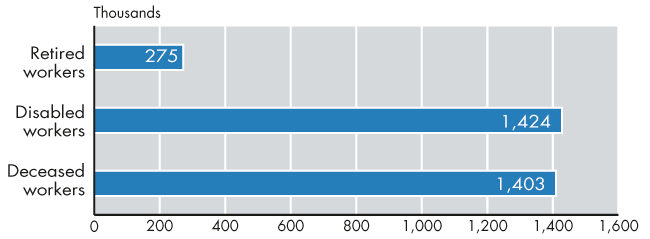
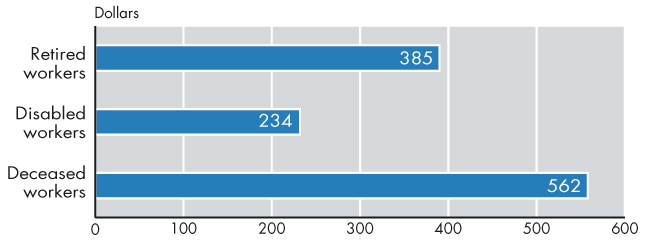
| Type of beneficiary | Number (thousands) |
Average monthly benefit (dollars) |
|---|---|---|
| Children of retired workers | 275 | 385 |
| Children of disabled workers | 1,424 | 234 |
| Children of deceased workers | 1,403 | 562 |
SSI Beneficiaries, 1974–2001
In 1974, when the program began, there were 70,900 blind and disabled children receiving SSI. That number increased gradually to 309,000 in 1990, rose sharply to 955,000 in 1996, and then declined gradually to 882,000 in 2001. The relatively high average payment to children (compared with payments made to blind and disabled adults) is due in part to a limited amount of other countable income. The spike in average monthly benefits in 1992 is due to retroactive payments resulting from the Sullivan v. Zebley decision.
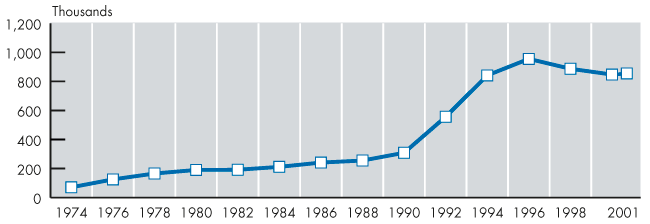
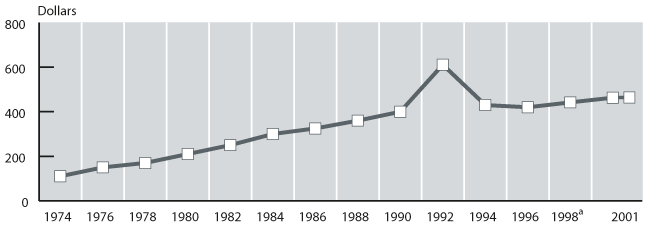
| Year | Number of children receiving SSI (in thousands) |
Average monthly SSI payment (in percent) a |
|---|---|---|
| 1974 | 70.90 | 109.15 |
| 1975 | 107.03 | 141.09 |
| 1976 | 125.41 | 154.24 |
| 1977 | 147.36 | 170.03 |
| 1978 | 165.90 | 171.72 |
| 1979 | 177.31 | 193.26 |
| 1980 | 190.39 | 219.08 |
| 1981 | 194.89 | 240.84 |
| 1982 | 191.57 | 263.22 |
| 1983 | 198.32 | 280.96 |
| 1984 | 211.59 | 292.86 |
| 1985 | 227.38 | 301.26 |
| 1986 | 241.20 | 321.34 |
| 1987 | 250.90 | 327.27 |
| 1988 | 255.14 | 343.24 |
| 1989 | 264.89 | 357.64 |
| 1990 | 308.59 | 403.72 |
| 1991 | 397.16 | 446.05 |
| 1992 | 556.47 | 610.98 |
| 1993 | 722.68 | 460.54 |
| 1994 | 841.47 | 448.07 |
| 1995 | 917.05 | 447.57 |
| 1996 | 955.17 | 442.01 |
| 1997 | 879.83 | 433.83 |
| 1998 | 887.07 | 441.75 |
| 1999 | 847.06 | 450.13 |
| 2000 | 846.78 | 463.05 |
| 2001 | 881.84 | 476.09 |
| a. As of 1998, these figures exclude retroactive payments. | ||